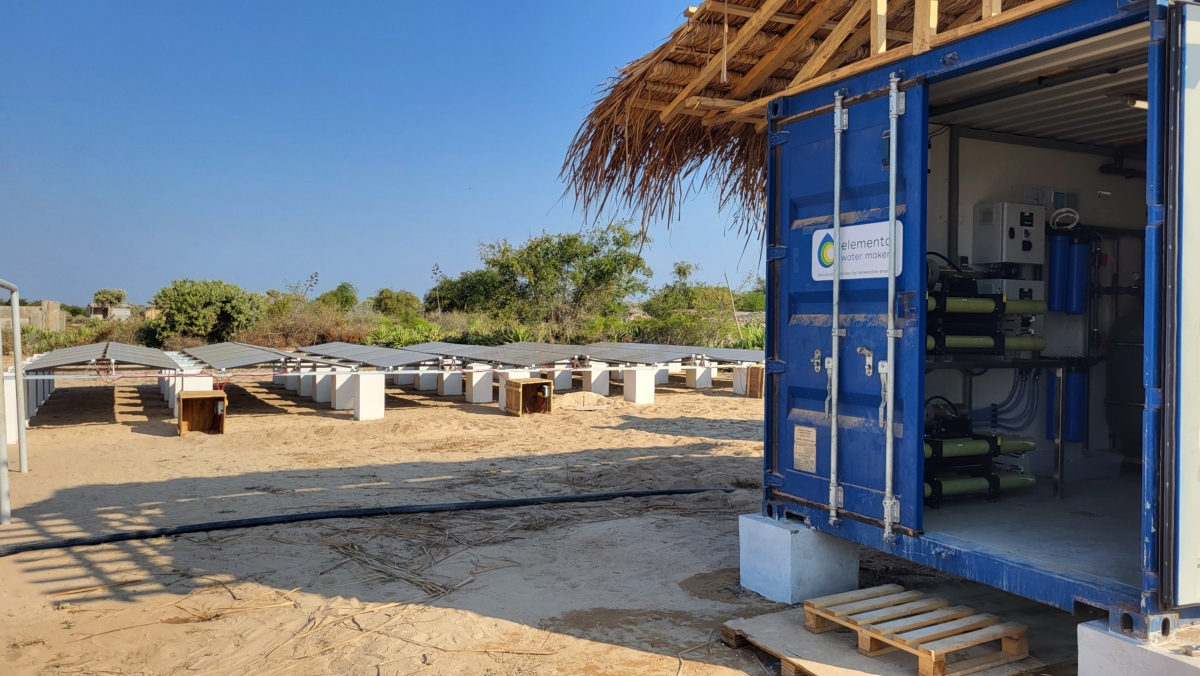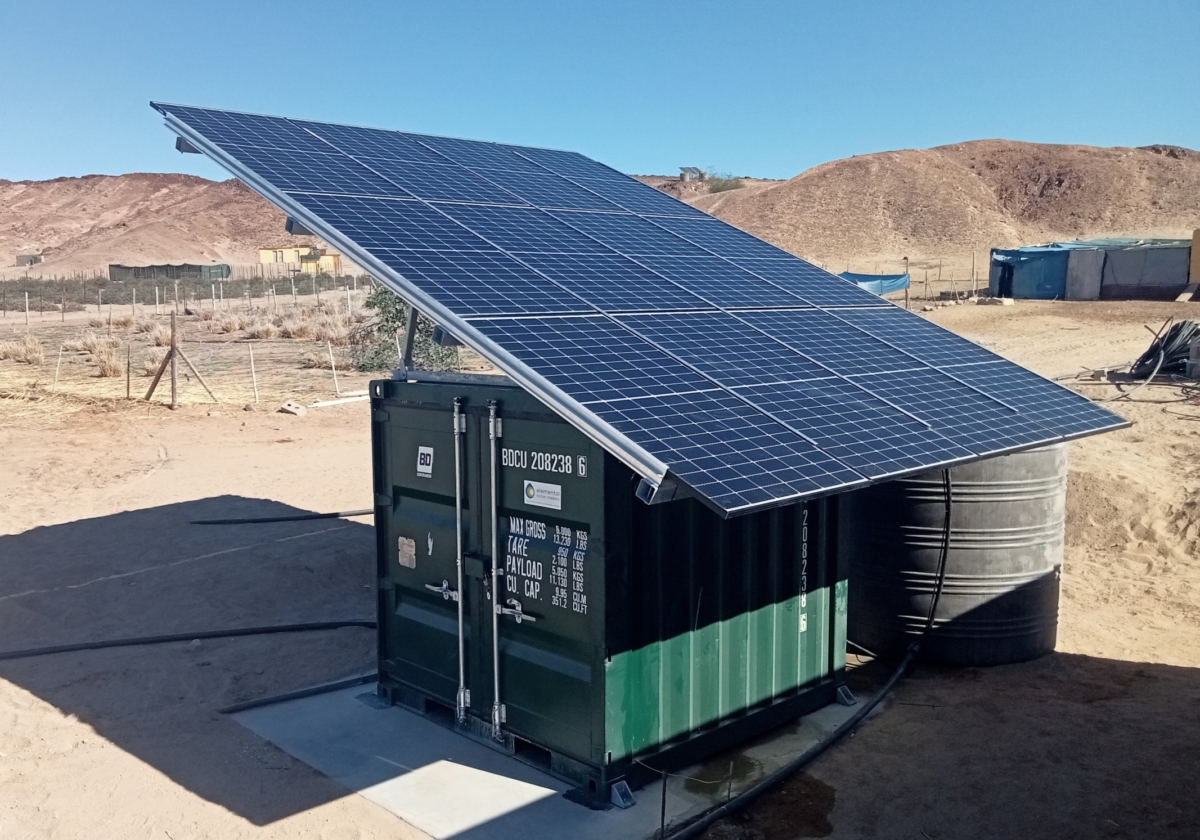A solar desalination system in 2025 typically costs between €60,000 and €400,000, depending on your daily water production needs, location, and whether you choose an off-grid or grid-connected solution. For resorts and private properties, these systems produce between 4,000 and 100,000 liters of fresh water daily, with total water costs ranging from €1 to €3 per cubic meter – significantly lower than the €5-10 per cubic meter many coastal properties currently pay for water delivery. The exact investment depends on factors like system capacity, site conditions, and local installation requirements, but most properties see complete payback within 1-5 years through dramatic reductions in water procurement and energy costs.

Solar desalination system in Madagascar that generates 30,000 liters of clean water, using only the seawater and sunshine.
What factors determine solar desalination system costs in 2025? #
The cost of your solar desalination system depends primarily on four key factors: daily water production capacity, installation location, energy source integration, and system configuration. Understanding these elements helps you budget accurately and choose the right solution for your property.
System capacity forms the foundation of pricing. Small systems producing 5,000 liters daily suit boutique resorts or private villas, while larger properties might need 50,000 to 100,000 liters daily. The relationship between size and cost isn’t linear – larger systems achieve better economies of scale, reducing your per-liter production cost significantly. A 100,000-liter system costs more upfront but delivers water at nearly half the per-cubic-meter cost of smaller units.
Your property’s location affects costs through several channels. Remote island locations face higher shipping costs for equipment delivery, while sites with challenging terrain might require additional civil works. Local labor rates vary dramatically between Caribbean, Pacific, and African installations. However, locations with abundant sunshine often require fewer solar panels, partially offsetting these expenses.
The choice between off-grid and grid-connected systems impacts both initial investment and operational costs. Off-grid solar desalination systems require larger solar arrays but eliminate ongoing electricity costs entirely. Grid-connected systems with energy recovery technology can reduce power consumption by up to 70%, making them ideal for properties with existing reliable power infrastructure.
How much can you save with solar desalination compared to traditional water sources? #
Solar desalination can reduce your water costs by 55-80% compared to traditional water procurement methods. With water delivery costs reaching €10-20 per cubic meter in remote coastal areas, switching to solar desalination that produces water for €1-3 per cubic meter delivers immediate operational savings.
The most dramatic savings come from energy efficiency improvements. Our solutions consume only 3 kWh per cubic meter of water produced, compared to 7-10 kWh for standard desalination solutions. This significant reduction in energy consumption translates directly to lower operational costs, whether you’re using solar power or grid electricity.
Over a 10-15 year system lifespan, the savings compound impressively. A mid-sized resort consuming 50 cubic meters daily could save over €100,000 annually on water procurement alone. Add the reduced maintenance costs from chemical-free operation and durable components like super duplex steel pumps, and total savings often exceed €1.5 million over the system’s lifetime.
Beyond direct cost savings, you gain protection from water price volatility and supply disruptions. Properties report stress-free operations with consistent water availability, eliminating emergency water deliveries during peak season when rates can double or triple.
The management team of Coco Beach Resort, located on Ambergris Caye in Belize, left the following review after implementing an energy-efficient desalination solution: ”What sets this system apart from those we’ve used in the past is the reliability and ease of operation. Maintenance has been minimal, and the system has proven to be significantly more efficient and user-friendly than its predecessors. Questions and technical support requests are answered quickly, and communication with the Elemental team has been top-notch. We are extremely pleased with the performance and service provided by Elemental Water Makers. For any property that requires a sustainable and dependable desalination solution, we would highly recommend their system and team.”
What are the upfront investment ranges for different system sizes? #
Investment ranges for solar desalination systems in 2025 vary based on daily production capacity, with costs including the complete system, installation, and commissioning. Here’s what you can expect for different property sizes:
| System Size | Daily Production | Investment Range | Container Size | Solar Power Required |
|---|---|---|---|---|
| Small | 5,000L | €70,000 | 8 foot | 5 kW |
| Medium | 20,000L | €120,000 | 20 foot | 18 kW |
| Large | 100,000L | €400,000 | 40 foot | 82 kW |
Modular design significantly reduces installation costs and time. Containerized plug-and-play systems arrive pre-assembled and tested, requiring minimal on-site work. This approach eliminates complex construction, reduces installation time from months to days, and ensures consistent quality across all installations.

Small solar desalination system fitted into an 8ft container, deployed to produce fresh water in Namibia
The investment includes more than just equipment. Your package typically covers system design for your specific conditions, shipping to your location, professional installation and commissioning, comprehensive operator training, and one year of operational support. Some suppliers also include remote monitoring systems and initial spare parts inventory.
Elemental Water Makers offers a direct purchase option, and for larger projects, a spread payment facility may be available depending on the client’s financials. Many properties find that monthly payments are lower than their previous water procurement costs, creating positive cash flow from day one.
How does location affect your solar desalination system pricing? #
Location impacts solar desalination pricing through multiple factors that can add 15-30% to base system costs. Understanding these variables helps you budget accurately and identify potential savings opportunities during project planning.
Solar irradiation levels at your site determine the size of solar array needed. Caribbean locations with consistent sunshine require fewer panels than Pacific islands with seasonal variations. Sites with 5-6 peak sun hours daily achieve optimal system efficiency, while cloudier locations might need 20-30% more solar capacity or hybrid power solutions.
Shipping costs vary dramatically based on your proximity to major ports. Remote islands face higher freight charges, especially for containerized systems. However, the modular design of modern systems allows for efficient shipping, with even large 100,000L/day systems fitting in standard 40-foot containers. African coastal installations often benefit from lower shipping costs due to established trade routes.
Site preparation requirements depend on your terrain and existing infrastructure. Level coastal sites need minimal groundwork, while hillside locations might require platforms or retaining walls. The availability of skilled local labor affects installation costs – established tourism destinations typically have experienced contractors familiar with technical installations, reducing supervision needs and project timelines.
Local regulations and permitting processes also influence total project costs. Some regions offer expedited approvals for sustainable water projects, while others require extensive environmental assessments. Elemental Water Makers can help in submitting the technical data that may be required to apply for the permits locally.
What financing options exist for resort and property water solutions? #
Elemental Water Makers offers a direct purchase option, which provides the fastest return on investment, typically achieving payback within 1-5 years depending on current water costs. This option works well for properties with available capital seeking to maximize long-term savings. For larger projects, a spread payment facility may be available depending on the client’s financials, reducing initial cash outlay while maintaining ownership benefits.
Due to the relatively small project sizes in terms of project finance, lease arrangements or water-as-a-service are generally not available through Elemental Water Makers, but may be explored by our local partners or local entrepreneurs. These alternative financing models could preserve working capital for other investments while providing immediate water cost savings.
Government incentives enhance all financing options. Many regions offer grants, tax credits, or accelerated depreciation for sustainable water infrastructure. Environmental funds and development banks increasingly support water security projects with favorable loan terms.
We work with properties to analyze which financing structure best fits your specific situation. Our plug-and-play solar desalination systems qualify for most financing programs, while our efficient desalination solutions for grid-connected properties often achieve the fastest payback periods. Together, we’ll create a financial plan that transforms your water challenges into sustainable, cost-effective solutions.
What’s the next step to find out how much a solar desalination project costs? #
If you are interested in learning the exact investment plus operational annual expenses, you can request a quote for your solar desalination project. With the basic information, which includes your project location, the water demand per day and current water expenses, we will help you with a cost-benefit analysis. Elemental Water Makers will calculate the payback time and total savings to determine the return on investment of your solar desalination project.
Frequently Asked Questions #
How long does it take to install a solar desalination system once ordered?
The installation time depends on the size of the system. Small systems typically take a few days to install, while larger systems may require several weeks. The modular design arrives pre-assembled and tested, requiring only connections to water intake/output and electrical systems. However, lead times for manufacturing and shipping can range from 8-16 weeks depending on system size and current demand, so planning ahead is essential for properties targeting specific operational dates.
What maintenance is required for solar desalination systems and who performs it?
Solar desalination systems require minimal maintenance - typically 2-4 hours weekly for routine checks and filter cleaning, plus quarterly deep cleaning of membranes. Most properties train existing maintenance staff to handle daily operations, while annual professional servicing ensures optimal performance. Remote monitoring systems alert operators to any issues before they affect water production, and many suppliers offer maintenance contracts that include spare parts and emergency support.
Can solar desalination systems handle varying water demands throughout the year?
Yes, modern systems adapt to seasonal demand fluctuations through modular design and intelligent control systems. You can operate partial capacity during low season to reduce energy consumption, or add additional modules for peak periods. Storage tanks buffer daily variations, while some properties install multiple smaller units instead of one large system, providing flexibility to match production with occupancy rates and reducing operational costs during quieter months.
What happens to the concentrated brine discharge from the desalination process?
Brine management depends on local regulations and site conditions, with most systems diluting concentrate before discharge to minimize environmental impact. Energy recovery devices capture pressure from the brine stream, reducing overall power consumption by up to 70%. Some innovative properties use brine for salt production, aquaculture, or mineral extraction, turning a waste product into additional revenue. Proper discharge design ensures rapid mixing with seawater, preventing localized salinity increases.
How do solar desalination systems perform during cloudy weather or at night?
Systems continue operating during cloudy conditions at reduced solar efficiency, with most designs including battery storage for 4-8 hours of autonomous operation. Grid-connected systems seamlessly switch between solar and grid power, ensuring uninterrupted water production. For completely off-grid installations, oversized solar arrays and extended battery banks maintain operations through typical weather patterns, while backup generators provide emergency power during extended cloudy periods.
What certifications and water quality standards do these systems meet?
Solar desalination systems produce water that meets WHO drinking water standards and EU Drinking Water Directive standards. Output typically shows less than 500 mg/L total dissolved solids, with customizable post-treatment for specific requirements. Systems include continuous monitoring of key parameters like salinity, with automatic shutdowns if quality deviates from set points.
